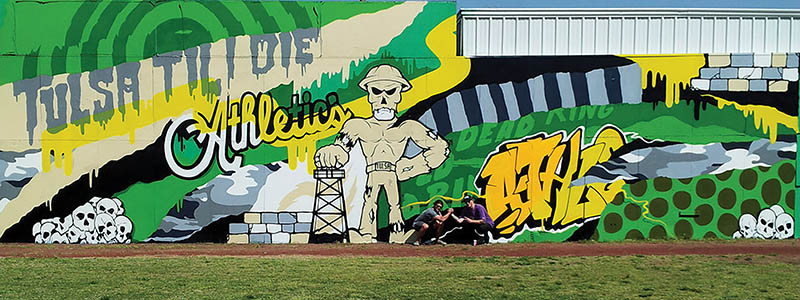Street fighters
Tulsa artists on the state of street art, the rules of engagement, and the line between good and evil
(page 4 of 4)

Growing up graffiti
Aaron Whisner is owner of the graphic-arts shop Clean Hands. Whisner is collaborating with Mary Beth Babcock, owner of Dwelling Spaces, for Public Works, a public-arts project. The mural on the west wall of The Woody Guthrie Museum in the Brady Arts District bears his name.
My mom was a designer, so I’ve been around graphic arts since I was in high school. I had a really supportive art teacher in high school, and she even had a wall that she got for us to paint at the school. We would go out there and mess around. We were really terrible, but she was supportive of anything you wanted to do.
When I started painting in the late ‘90s, [Tulsa] had one shop [on Brookside], Thing One. They had all these graffiti magazines, shirts, records, photos on the wall. It was kind of, go in there and soak it in. Since they went out, there really hasn’t been anything like that in Tulsa. Most people who start doing this are teenagers. [It’s] boredom or it seems cool. It’s not like ‘Oh, I’m gonna make a career out of being a street artist.’
The street-art label—back then we were just painting, and it didn’t really have a term. I think that’s kind of a corny name for it. It all goes into it—there’s piecing, there are tags, there are bombs. Piecing is doing your best work and taking your time. It’s usually commissioned. A bomb or a throw is really quick, just to get your name up. You just go paint something. I mean, do what you want to do. It’s just funny because when I started, you really had to go out and risk a lot. Now it’s exposed in documentaries and the Internet, people think you just hop in, it’s that easy. But it takes a lot—you really have to be dedicated to it.
You say the word ‘graffiti’ and people have an impression of what it means. To each person it’s something different. On this back wall [at the Clean Hands shop] we have all these murals, and some people are like, ‘That’s just graffiti!’ To some people that’s a negative. People just have different views of public space and what it should be used for. To me, I like seeing it. Some people don’t like seeing it, but there are lots of other things we don’t like that other people do. Like, you might not like that someone’s a gun owner, but as Americans, in my opinion, we have that freedom. Some people, they don’t really see the merit in it. Sometimes I think there is some pure vandalism, but even still.
The city has a graffiti-removal squad. Back in the day they used to have just two guys. It was funny because on the 169 bridge we’d write little messages [to them]. That used to be the spot you’d go to see who’s painting. Our dumpster gets tagged a lot. They’ve come and asked if I want it painted over. Seems to me like a waste of money to paint a trashcan that’s full of shit. They’ve even asked about our back wall. They think it’s illegal.
Obviously, you’ve seen in Tulsa, at least in the news media, [graffiti] is portrayed as a negative thing with all the bust stories. Some of those shots are legal projects. In a way, it just depends on where you’re at. Some cities support it more. I was just on the East Coast, and it’s everywhere there.
I think the general public wants to see it. With the Internet and movies, it’s become a cool thing, and some people use it in marketing. But to me there will always be a cool edge. You’re writing your name on something. It starts when you’re a kid. You’re not supposed to write your name on that wall but we do it. Sorta like human nature. You want people to know you’ve been there.


.jpg)
.jpg)
